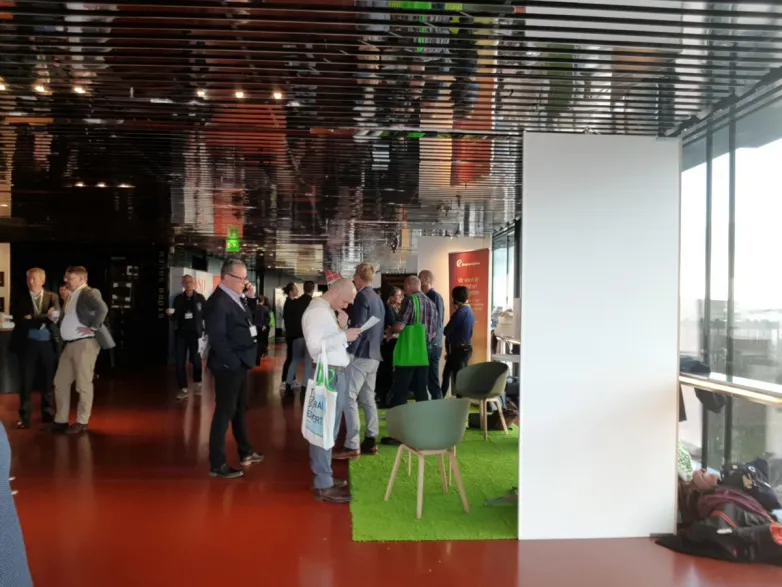Swedish Solar Expo touts solar and hydrogen community project
Oct 30, 2019 03:06 PM ET
- Where seasonal storage is paramount, hydrogen comes into play. Under-the-radar solar market Sweden has presented its hydrogen projects and technological solutions to overcome the country’s natural solar barriers.

Visitors to Sweden often note an affinity to technology in public and daily life, an urge to make everything quicker, smoother, neater and simpler is evident almost everywhere. It should come as no surprise then, to learn Sweden’s solar community did not disappoint when it came to presenting technology solutions that flew in the face of harsh winters and meager solar irradiation half the year round.
An enthused crowd of solar installers, manufacturers and distributors – as well as city council representatives – visited the country’s most prominent solar energy event – Solmässan, held today in the city of Uppsala, not too far from Stockholm.
Sweden had just 180 MW of solar generation capacity installed last year. That small figure represented 100% growth from the previous year and industry insiders expect an 80% leap this year and see no reason for the pattern to change in 2020.
As implied by the capacity figure quoted, residential installations drive Swedish PV at present. Joan Carlehed, manager of sustainable development at flat-pack furniture king Ikea, was delighted his employer is now selling its Solstråle (Sunray) solar system in its own back yard. Ikea launched the product in Germany and Italy but has now been shifting units in Sweden for a month or so. “We have been selling a lot and the customer response is excellent,” Carlehed told pv magazine. Back on stage, the manager shared the company’s vision of sustainable living for 1 billion people by 2030.
Solar system capacity cap
The furniture retailer is doing its bit despite a national 255 kW generation capacity cap for privately-owned solar systems. Ikea could easily bust through that limit on its warehouse roofspace and Carlehed was not alone in calling for the cap to be removed. Filip Elland, of real-estate company Castellum, said the restriction has limited commercial and industrial PV installations by 45%.
The privately-owned solar system capacity ceiling was introduced in an attempt to avoid overburdening the grid but Swedish companies and municipalities say they want to forge ahead and install solar and hydrogen systems to provide them with year-round renewable energy, heat and transport.
Hans Olof Nilson, CEO of Nilsson Energy, told attendees in Uppsala of his company’s ambition to turn homes and apartment blocks into energy independent entities with the help of solar-powered hydrogen electrolysis and fuel cells. It is no pipe dream. After installing the system on a demonstration house near Gothenburg in 2015, Nilsson founded the company and is now realizing such projects in Sweden.
Susanné Wallner, development strategist for the city of Mariestad, on Lake Vännern, said the municipality is home to the world’s first solar-powered hydrogen fueling station for cars, has installed monorail, on-the-go battery charging stations for electric buses, is planning a hydrogen train and wants to use the element to power public buildings such as kindergartens and housing projects.
Grid ancillary services
A desire for the same problem-solving, get-up-and-go approach to combating climate change was thwarted in Uppsala, according to Ulf Näslund, from real estate company Vasakronan, and regional representative Marcus Nystrand. The pair described how a plan to charge electric buses directly from a 4.7 MW solar project was stymied because the solar electricity generated has to be injected into the grid instead.
And as the energy storage industry repeats calls for policymakers around the world to recognize the value of its grid balancing services, it appears Sweden isn’t hangin’ about. “The market for such [grid frequency regulation] products was designed around hydropower stations many years ago,” said Johanna Lakso, of electromobility industry group Power Circle. “The minimum power you had to provide was 10 MW.” Next year, that figure will fall to 1 MW or 100 kW, depending on the grid ancillary service on offer. “At these levels, aggregators could step in and offer residential solar and battery power on the market for these services,” said Lakso.
Where regulatory change is not swift enough, there is always that sense of Swedish innovation, as Jörn Passoth from Ecosand Nord AB explained. His company shaved SEK500,000 ($51,000) per year off Uppsala council’s heating bill. How? By developing a type of sand used between the fibers of outdoor astroturf soccer pitches that does not freeze when the temperatures fall.
You see, it doesn’t all have to be about solar.
Also read
- CNNP Optoelectronics brings utility-scale perovskite modules out of the lab
- Low-Temperature Sequential Deposition Lifts Inverted Perovskite Solar Cells Efficiency Record
- ARENA Backs Luminous Robots for Solar Innovation Boost
- TotalEnergies Expands Caribbean Renewables, Divests Half Stake of Portuguese Portfolio
- Self-Assembling Molecule Breakthrough Brings Commercial Perovskite Solar Closer to Market
